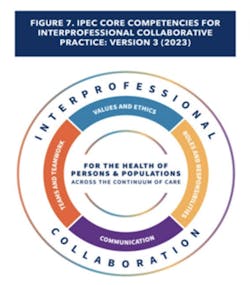An introduction to interprofessionalism in dentistry
Listen to the article on our podcast!
In the past, oral health literature often referred to the relationship between dentistry and dental hygiene as "interprofessional," but this has been becoming more popular in the industry recently. However, polarized perspectives of professional identities and roles still exist between dentists and dental hygienists, which can complicate collaboration.1
According to the World Health Organization (WHO), interprofessional collaborative practice can be defined as "when multiple health-care workers from different professional backgrounds provide comprehensive services by working with patients, their families, caregivers, and communities to deliver the highest quality of care."2
When collaborating between health-care providers, it is essential to follow the four core competencies of interprofessional collaboration. But what are they?
Values and ethics: Work with individuals of other professions to maintain a climate of mutual respect and shared values.
Roles and responsibilities: Use the knowledge of one's own role and those of other professions to appropriately assess and address the needs of patients, and promote and advance the health of populations.
Communication: Communicate with patients, families, communities, and professionals in a responsive and responsible manner. Communication should be team-oriented and be centered on health as well as the prevention and treatment of disease.
Team and teamwork: Apply relationship-building values and the principles of team dynamics to effectively perform in different team roles involving planning, delivering, and evaluating patient/population-centered care. Population health programs and policies should be safe, timely, efficient, effective, and equitable.3
Putting these competencies to work
As registered dental hygienists, we have an important role in the interprofessional health-care paradigm, especially because we see a larger client population in comparison to other health-care professionals. We also understand the relationship between oral and systemic health, which allows us to be disease prevention specialists.
As part of a routine practice, say, we may check a patient's blood pressure. If the blood pressure appears to be higher than normal, we are able to take appropriate measures and communicate with our patient and other members in the patient's interprofessional team such as their family physician.
Additionally, we often work with patients who have complex medical histories or those with risk factors that require an interdisciplinary approach. I had a patient who was on a few medications come in for a routine three-month appointment. At the time of the dental appointment, the patient showed a blood pressure reading that was higher than usual. The DDS prescribed a panoramic radiograph, and on this radiograph, we noticed that the patient's carotid artery was calcified. We notified the patient and immediately collaborated with other members on the interdisciplinary team. Two days after his dental visit, the patient had a stent placed. If we didn't take the preventive measures-and if our collaboration skills lacked-the patient outcome could have been very different.
Collaborating between health-care providers is key to success. By understanding and implementing the four core competencies of interprofessional collaboration, the professional relationship between dentists and dental hygienists can grow and evolve over time.
References
-
Howey ML, Yoon MN. Insights in interprofessional education: Dental hygiene students' suggestions for collaboration. Can J Dent Hyg. 2022 Feb 1;56(1):9-21. PMID: 35401761; PMCID: PMC8937569
-
Framework for Action on Interprofessional Education & Collaborative Practice. Geneva: World Health Organization (WHO). 2010.
-
Zorek JA, Ragucci K, McKearney S, Breitbach, A, Kirschling J, Singh P, Steinkopf M, et al. IPEC core competencies for interprofessional collaborative practice. Version 3. November 20, 2023:I-IV; 1-53. https://www.ipecollaborative.org/assets/corecompetencies/IPEC_Core_Competencies_Version_3_2023.pdf.
About the Author

Whitney Foster, RDH
Whitney Foster, RDH, has a demonstrated history of working in various roles in the dental field. In the last year, Whitney has been published in various publications within the industry and developed a continuing educational course that focused on interprofessional collaboration. With her passion for oral health care and the relationship to overall health, Whitney continues to support, mentor, and advocate on the subject for fellow dental hygienists.

